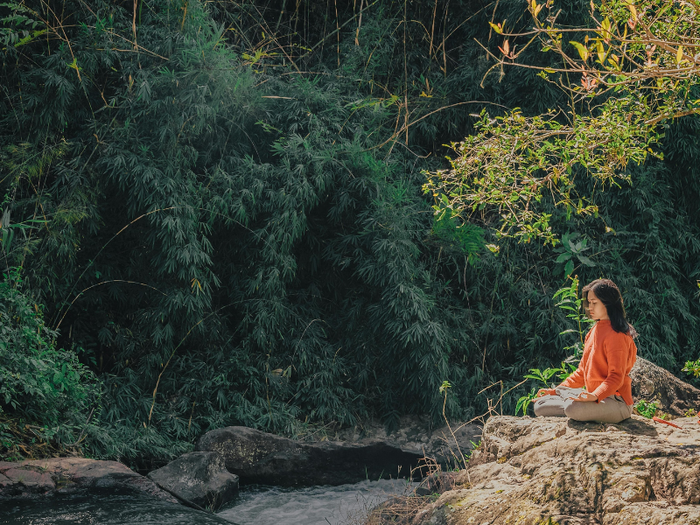Integrating Meditation into General Yoga Classes with Isabell Britsch
Meditation is an integral part of yoga and not separate from it. Iyengar states that yoga is meditation and meditation is yoga. Even if we only teach asana, it is very likely that as yoga teachers we already emphasize a sense of presence, attention, mindfulness, kindness, and care in our classes, thereby establishing important aspects of what meditation is. One could argue that Patanjali’s 8 limbs of yoga are mostly concerned with preparing for and deepening meditation and training the mind – historically, yoga is meditation.
How can breathwork and postural practice prepare the body and mind for meditation?
Āsana and prāṇāyāma both help prepare for meditation and also operate as a bridge between the external world and the internal environment. Postures prepare the body physically for a more comfortable seated posture by mobilizing and strengthening the body, particularly focusing on muscle groups that support the spine and open the hips. Movement supports a settling of the mind, which has a calming and stabilizing effect on the nervous system.
The purpose of preparatory postures might be to:
● prepare the body physically for a more comfortable seated posture
● wake the student up in an early morning class
● help the student transition from a busy day in an evening class
● bring awareness into the body
● support a settling of the mind by doing something more active that already invites a sense of presence before coming to stillness.
● balance or calm the nervous system through posture choices (e.g. forward bends, restorative postures, legs up the wall, etc.)
Purpose of pranayama:
● breathwork further helps to (a) root attention in the present moment and (b) balance the nervous system.
● we can use breathwork to balance the nervous system and bring the energy down, lift it up, or balance it.
● you can seamlessly move in your language and guidance from controlling to observing the breath (a classic anchor in meditation).
What are the different meditation postures, and how do you choose the right posture for specific contexts?
With our choice of posture we’re looking after the body and keeping it as comfortable as possible: shtira sukham asanam.
Good posture is stable and clear, but relaxed – it allows the body and mind to feel balanced, yet alert. The best posture is the one we can sustain with the least amount of discomfort and the most clarity of mind. A seated pose often provides the best balance between alertness and relaxation, effort and ease.
But there can certainly be other postures:
● standing: great if there’s discomfort in the body or a lot of tiredness (it’s hard to fall asleep when you’re standing). Very portable – we can do a standing meditation while waiting for the bus.
● walking: can create a great bridge from formal to informal practice and to daily life. Great if the mind is restless as it’s more active. Can easily be done outdoors.
● lying down: great if there’s excess discomfort in the body. Can be difficult to sustain (even if you don’t fall asleep the mind is often quite blurry, drowsy and hard to focus). Can work well if there’s more guidance in the meditation.
Meditation is not an endurance test in a perceived best posture. The main purpose in our choice of posture is to keep the distractions of the body to the mind to a minimum.
Why is language important when structuring and teaching a guided meditation?
Our voice and how we use it is a powerful tool and our language will have an impact on:
● the environment we create
● the practices we lead and how they land
● our students’ understanding and enjoyment of those practices
● our students’ desire and ability to develop and deepen their own practice.
When we guide meditation we aim to use language that is
● clear and concise in its descriptions
● invitational and inclusive
● appropriate and encouraging
● authentic and genuine
What are some key obstacles and cautions to consider when introducing meditation to students?
Meditation can be a way to calm the mind, deepen our understanding of ourselves, and promote kindness and compassion. This can be incredibly helpful and supportive. And equally, others could feel overwhelmed, frustrated, or simply incredibly bored.
It’s useful to bear in mind that (a) results will very likely not be instant, and (b) different things work for different people.
Key obstacles:
● distraction: e.g. by external sounds, random thoughts. To get distracted is normal…
● persistent thoughts and emotions.
● discomfort in the body – this is why it’s so important to know your posture options.
● looking for a particular experience (e.g. a ‘blissful’ experience, a solution to all your problems)
● boredom
● getting sleepy, nodding off, tiredness, dullness of mind
● restlessness of body (fidgeting) or mind (a lot of thinking)
● doubt: questioning whether this is the right practice, the best teacher, or whether we’re doing it right, etc.
It’s useful to acknowledge that quite often the progress or success of our meditation practice isn’t so much visible during the practice than it is in our daily life.
And also, meditation isn’t for everyone. And certainly, some people will benefit from modifications or alternatives if meditation feels dysregulating and brings up thoughts that are difficult to face. This might particularly apply if
● mental health is severely impacted at the moment
● there are unresolved addictions
● there’s a history of or recent traumatic experience
Although of course the lines are blurred and for some fitting into the above categories meditation might actually be very helpful.
Could you elaborate on the post-meditation inquiry process and its significance in personal and teaching practice?
Post meditation inquiry is a great way to see how the practice has landed and to learn from it. It can clarify the experience we’ve had and – importantly – connect it to daily life.
Then we can deepen our understanding and learn from it, which can then be the starting point for a longer lasting influence on how we live.
Inquiry can:
● highlight our habits
● bring attention to obstacles and how to resolve them
● enable the group to receive valuable learning points through observing and processing someone else’s inquiry
If you would like to explore Integrating Meditation into General Yoga Classes with Isabell you can join her workshops; Integrating Meditation into General Yoga Classes taking place Wednesday, 19th June, 9:30 am - 4:30 pm UK time.
Upcoming Courses

Breathe New Life into Your Body! Enhance Your Well-Being with Somatic Awareness
30th April 2025 • Online Live Tias Little
- Details and booking

Meditation Teacher Certification
1st October 2025 • Online Live • Graham Burns Isabell Britsch
- Details and booking

Pelvic Integration Masterclass: Connecting to the Seat of Movement
17th May 2025 • Face to face Mary Richards
- Details and booking

Guiding Meditation (part of The Meditation Series)
20th August 2025 • Online Live • Graham Burns Isabell Britsch
- Details and booking

Meditation is All in the Mind (or is it?) (part of The Meditation Series)
17th September 2025 • Online Live Isabell Britsch
- Details and booking

Meditation Roots and Shoots (part of The Meditation Series)
15th July 2025 • Online Live • Graham Burns Isabell Britsch
- Details and booking

Meditation Myths De-bunked (part of The Meditation Series)
3rd June 2025 • Online Live • Graham Burns Isabell Britsch
- Details and booking

Chakra Yoga: Healing and Transformation through working with the Chakras
16th July 2025 • Online (Pre-Recorded) Katrina Repka
- Details and booking

Foundations in Teaching Mindfulness Meditation
9th July 2025 • Online (Pre-Recorded) Michael Stone
- Details and booking

A Practical Guide to Teaching and Sequencing a Restorative Yoga Practice
10th June 2025 • Online Live Adelene Cheong
- Details and booking

